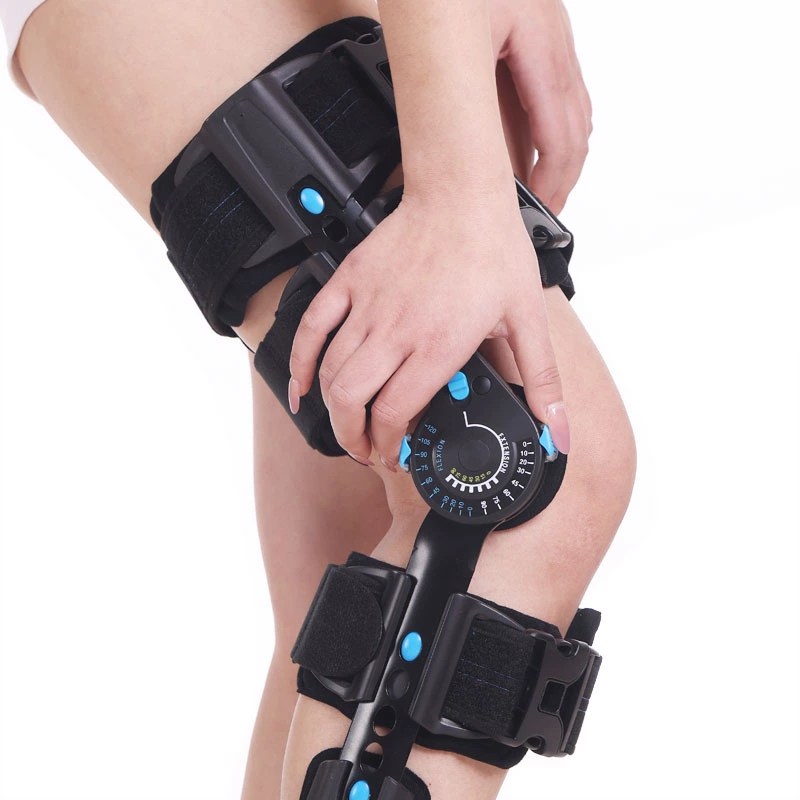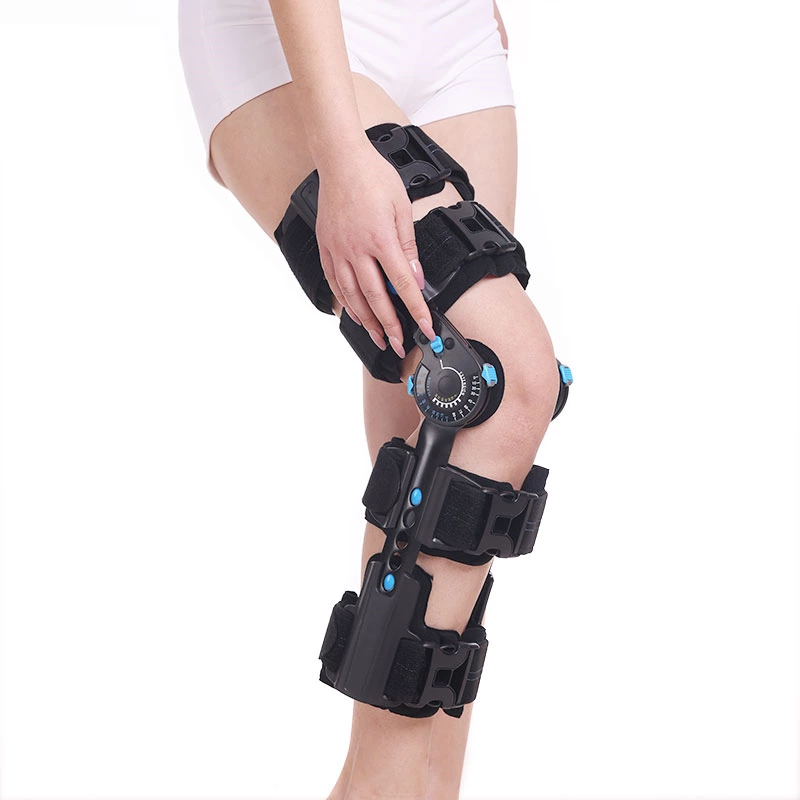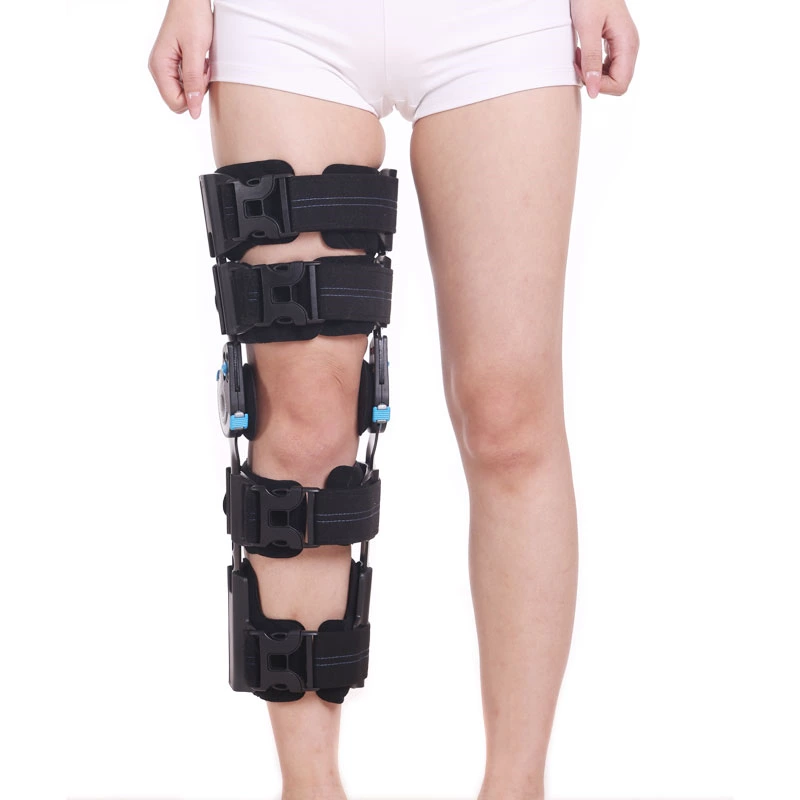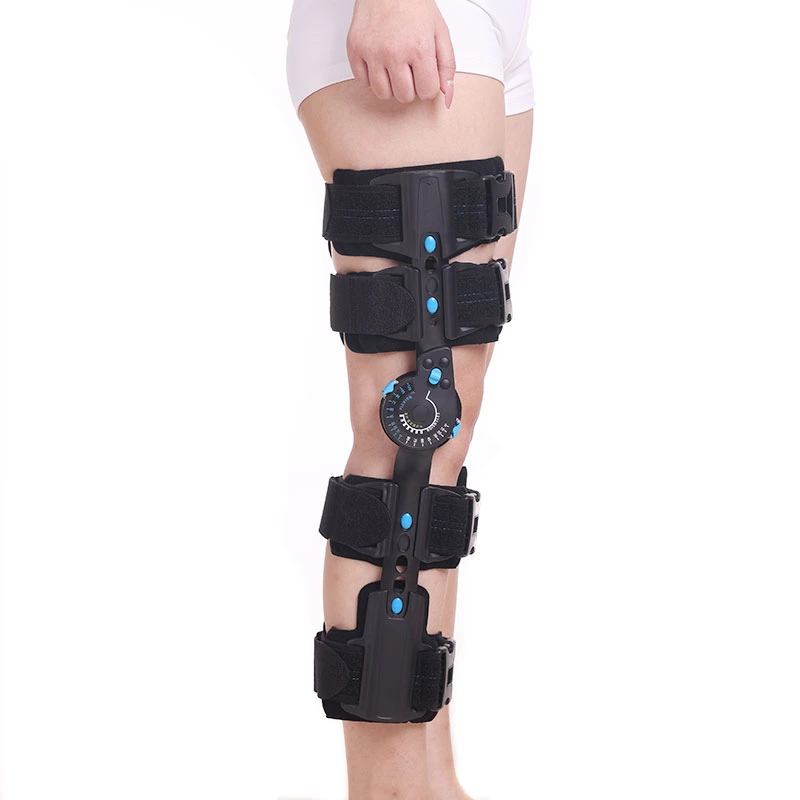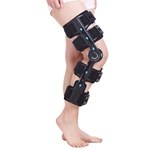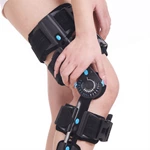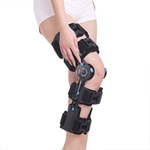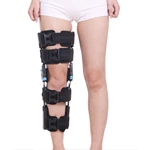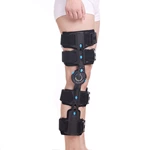Orthopedic Hinged ROM Lockable Knee Brace For Post Op
hinged knee brace applicable to the external fixation of knee joint bone and soft - tissue injuries, the prevention and correction of knee joint contracture, and the control of the functional position of the knee joint.
- Code
- F301-19
- Size
- One Size Fit All
- Color
- Black
Indications
- Knee joint fractures
- Patellar fracture: It is mostly caused by direct violence (such as the knee directly hitting the ground when falling) or indirect violence (such as a sudden and forceful contraction of the quadriceps femoris). The adjustable knee joint hinged knee brace can fix the knee joint in an appropriate extended or slightly flexed position, which helps to stabilize it after fracture reduction, avoid displacement of the fracture fragments, and provide a good mechanical environment for fracture healing.
- Tibial plateau fracture: It is often caused by powerful violence such as falling from a height or a traffic accident. Using a orthopedic hinged knee brace can effectively limit the movement of the knee joint, reduce the pressure on the fracture site, prevent further collapse of the articular surface, promote fracture healing, and help maintain the normal shape of the knee joint.
- Femoral condyle fracture: This kind of fracture is also mostly caused by high-energy injuries. The hinged knee brace can help fix the knee joint, reduce the displacement of the fracture ends caused by factors such as muscle traction, and assist in the treatment process of the fracture.
- Knee joint dislocation
- Knee joint dislocation is a serious injury that can be caused by powerful external forces, such as severe collisions during sports or high-energy trauma. After reduction, the adjustable knee joint drop lock knee brace can keep the knee joint in a stable position, prevent recurrence of dislocation, and at the same time allow for appropriate adjustment of the fixation angle according to the recovery situation during the rehabilitation process, promoting the repair of the soft tissues around the joint and the recovery of joint function.
- Soft tissue injuries of the knee joint
- Meniscus injury: It often occurs under the action of torsional external forces, such as turning around in basketball or changing direction in football. Using a locking hinged knee brace can limit the torsion and excessive flexion and extension of the knee joint, reduce the force on the meniscus, relieve pain, and create conditions for the self-repair of the meniscus.
- Patellar tendon injury: It is mostly caused by excessive exercise or sudden violent traction. The ROM knee brace limits the range of motion of the knee joint, reduces the tension of the patellar tendon, helps the injured patellar tendon recover, and prevents further tearing.
- Quadriceps femoris tendon injury: Similar to patellar tendon injury, after the quadriceps femoris tendon is injured, the lockable knee brace can control the flexion and extension of the knee joint, reduce the burden on the tendon, and promote the repair of the tendon.
- Knee joint inflammation
- Rheumatoid arthritis: It is an autoimmune disease that mainly attacks the synovium of joints. When the knee joint is affected, the inflammation will cause joint swelling, pain, and limited mobility. The adjustable knee joint drop lock knee brace can fix the knee joint during the inflammatory episode, reduce the burden on the joint, relieve pain, and at the same time, the angle can be appropriately adjusted during the remission period to assist the joint in carrying out small-scale activities and prevent joint stiffness.
- Traumatic arthritis: It is usually caused by damage to the articular cartilage, meniscus and other structures after knee joint trauma, and long-term wear leads to joint inflammation. The hinged metal knee brace can limit the abnormal movement of the joint, reduce the friction of the articular surface, relieve the symptoms of inflammation, and improve the quality of life of patients.
- Suppurative arthritis: It is mostly caused by bacterial infection, and suppurative inflammation will occur in the joint. During the treatment process, in addition to using antibiotics and other drug treatments, fixing the knee joint can reduce the spread of inflammation, relieve the pain of patients, and assist in the control of inflammation.
- Postoperative rehabilitation of the knee joint
- After knee joint replacement surgery: After the knee joint is replaced surgically, a hinged knee brace for torn meniscus needs to be used to keep the knee joint in the correct position, prevent the displacement of the prosthesis, and at the same time, the angle can be adjusted according to the doctor's advice during the rehabilitation stage to gradually increase the range of motion of the knee joint and promote postoperative rehabilitation.
- After ligament reconstruction surgery: Whether it is anterior cruciate ligament, posterior cruciate ligament or medial and lateral collateral ligament reconstruction surgery, the knee brace range of motion can help stabilize the knee joint, ensure that the reconstructed ligament heals under appropriate tension, and can flexibly adjust the fixation angle during the recovery process to meet the needs of different rehabilitation stages.
- After meniscus repair or partial resection surgery: The knee fracture brace can limit the movement of the knee joint, avoid secondary damage to the repaired or remaining meniscus tissue, and guide the recovery of knee joint function by adjusting the angle during the rehabilitation process.


